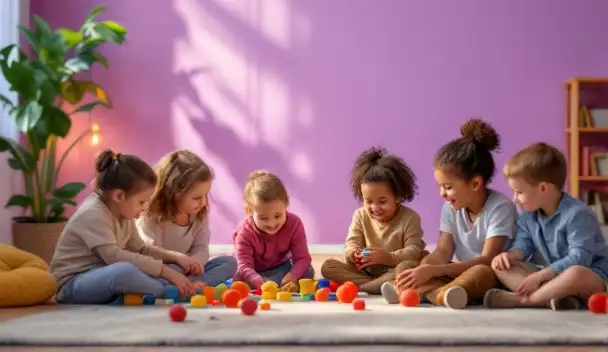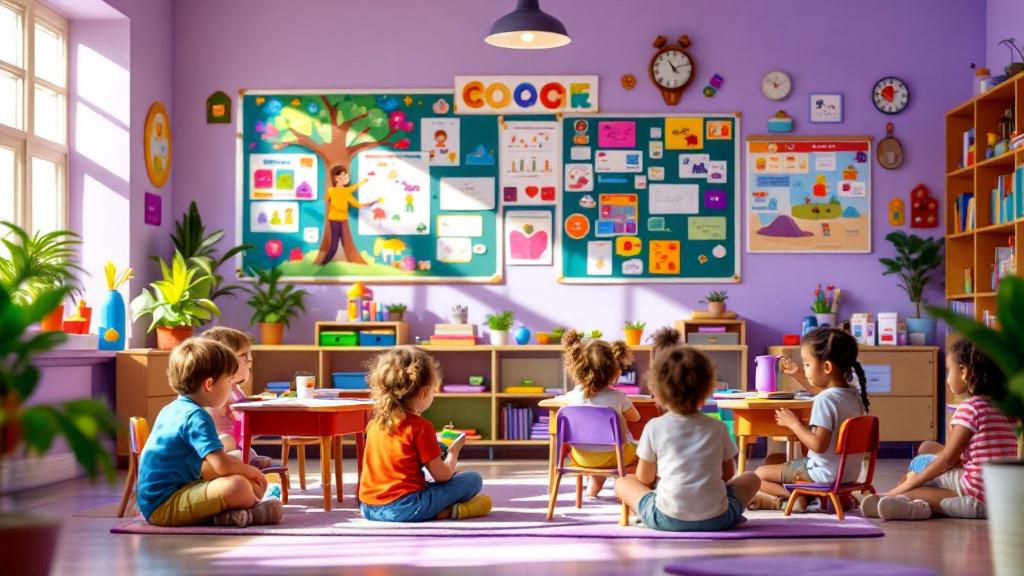Understanding Empathy Development in Children with Autism
Empathy is a foundational social skill that enables children to connect emotionally with others, recognize and respond appropriately to feelings, and navigate social interactions effectively. For children with autism, developing empathy presents specific challenges due to difficulties in interpreting social cues, understanding emotions, and engaging in reciprocal social behaviors. Applied Behavior Analysis (ABA) offers a structured, evidence-based approach to teaching these complex skills. This article explores various methods and tools used within ABA strategies to help children with autism nurture empathy, supported by developmental insights, practical tools, and instructional techniques.
Foundational Techniques for Empathy Development in ABA

What tools and techniques can be used to foster empathy in children, such as empathy maps and picture cards?
To support children in developing empathy, educators and therapists employ a variety of visual and interactive tools. Using picture cards that depict different emotional expressions allows children to label and recognize emotions in themselves and others. These visual aids are often incorporated into social stories—narratives tailored to teach social expectations and emotional understanding—that help children grasp social cues.
Role-playing activities are another effective method. Children can practice responding to social situations with puppets or through video modeling, which provides concrete examples of appropriate behaviors and emotional responses. These role-playing exercises help children rehearse social interactions in a safe environment.
Video modeling is particularly useful for addressing nonverbal cues like body language and facial expressions. Through interactive exercises, children learn to interpret these cues accurately, improving their ability to understand and respond empathetically.
Altogether, these tools—picture cards, social stories, role-playing, and video modeling—offer practical ways to build emotional vocabulary and foster understanding of others’ feelings.
| Tool/Technique | Description | Benefits |
|---|---|---|
| Picture Cards | Visual images illustrating different emotions | Recognizes emotions, expands vocabulary |
| Social Stories | Narratives teaching social cues and expectations | Improves social understanding |
| Role-Playing | Acting out social scenarios using puppets or scripts | Rehearses responses, builds confidence |
| Video Modeling | Using videos to demonstrate social behaviors | Enhances recognition of nonverbal cues |
Incorporating these methods within ABA therapy can significantly improve children’s ability to empathize and engage socially with others.
Developmental Stages of Empathy in Children and Caregiver Support
What are the developmental stages of empathy in children, and how can caregivers support them?
Empathy in children develops through several key stages, starting from infancy. In the earliest months, infants display global empathy by reacting emotionally to others' distress, such as crying when they hear other babies cry. This early response lays the groundwork for later social understanding.
As toddlers and preschoolers, children begin to show egocentric empathy. They respond to others' feelings but may still struggle with perspective-taking. During these years, children’s understanding of different emotions deepens, especially as they engage in social interactions and observe emotional responses.
Between ages three to five, children typically develop a theory of mind. This allows them to understand that others have feelings, thoughts, and perspectives different from their own. They start recognizing social cues, which supports more nuanced emotional understanding. By around age six or seven, cognitive empathy becomes more developed, enabling children to imagine how someone else feels and to respond appropriately.
Caregivers play a vital role throughout this process. Supporting early attachment security through consistent caregiving provides a safe emotional foundation. Modeling empathetic behaviors, such as expressing understanding and kindness, helps children learn social cues and responses.
Engaging children in activities like storytelling, pretend play, and discussions about emotions can reinforce empathy development at all stages. Reading books that depict characters’ feelings or acting out social situations encourages perspective-taking and emotional vocabulary growth.
Reflection on own and others’ feelings, combined with positive reinforcement and open conversations about emotions, nurtures empathy. Recognizing that empathy is a lifelong journey, caregivers' ongoing support, patience, and modeling are essential for fostering empathetic, socially competent individuals.
Using Visual Aids and Storytelling in ABA to Teach Emotions and Social Cues

How can emotion recognition be supported using photographs and body maps?
Visual aids like photographs and body maps are instrumental in helping children identify and understand emotions. Photographs of facial expressions display a range of feelings, enabling children to label emotions accurately. Body maps take this a step further by highlighting physical sensations linked to emotional states, such as a racing heart when anxious or a warm feeling when happy. These tools expand emotional vocabulary and improve awareness.
Using body maps allows children to connect physical sensations to emotional experiences, fostering a deeper understanding of themselves and others. When children recognize these cues, they become more adept at interpreting emotions in social situations, which lays the groundwork for empathetic responses.
How do social stories and comic strip conversations enhance understanding?
Social stories and comic strip conversations are designed by professionals like Carol Gray to explain social expectations and social cues in a structured and engaging way. These narratives depict real-life scenarios and illustrate appropriate reactions, helping children with autism grasp complex social rules.
Social stories break down social interactions into simple, clear steps, making them easier to understand. Comic strip conversations use visual dialogue and illustrations to demonstrate how children can respond in various contexts—such as sharing feelings or respecting boundaries. These tools reinforce positive social behaviors and encourage children to practice empathy.
What techniques are effective for fostering empathy through ABA methods?
In ABA therapy, several techniques support empathy development. Role-playing exercises allow children to rehearse social scenarios like recognizing emotions in others and responding suitably. Video modeling offers visual examples of empathetic behaviors, helping children imitate and understand appropriate responses.
Reinforcement strategies are also critical; praising children for correctly identifying emotions or displaying empathetic behaviors encourages repeat performances. Prompting, including manual guidance and verbal cues, helps children learn behaviors step-by-step. As skills are practiced repeatedly, they become more natural and transferable to everyday life.
How do these strategies work together to improve social and emotional understanding?
Combining visual supports, storytelling, role-play, and reinforcement creates a comprehensive approach to teaching empathy. Visual aids help children recognize emotional expressions, while stories contextualize these emotions in real-life situations. Role-playing offers hands-on practice, and reinforcement solidifies learning.
This integrated approach ensures children with autism learn to interpret social cues, understand others’ perspectives, and respond appropriately. Over time, these skills foster empathy, improve social interactions, and support overall social competence.
Summary Table of Methods and Tools
| Tool/Method | Purpose | Example | Benefits |
|---|---|---|---|
| Photographs | Recognize facial expressions | Feelings chart | Expands emotional vocabulary |
| Body maps | Link physical sensations to emotions | Physical sensation zones | Deepens emotional awareness |
| Social stories | Explain social norms | Scenarios for sharing | Clarifies expectations |
| Comic strip conversations | Visual dialogue about feelings | Feelings and responses | Reinforces social scripts |
| Role-playing | Practice social responses | Rehearsing greetings | Enhances real-world skills |
| Video modeling | Demonstrate empathetic behavior | Watching caring peers | Builds imitation skills |
| Reinforcement | Encourage desired behaviors | Praise, tokens | Motivates ongoing practice |
Employing these varied strategies allows children on the autism spectrum to develop a richer understanding of emotions and social cues. This, in turn, promotes empathy and improves their ability to engage positively with others.
Teaching Boundaries and Social Cues Effectively

What are effective methods for teaching empathy skills to children with autism using ABA strategies?
Applied Behavior Analysis (ABA) offers several effective methods to foster empathy in children with autism. One prominent approach involves systematic instruction in recognizing social cues and emotional states through tools like social stories, visual supports, and video modeling. These methods help children understand complex social information in a simplified and engaging way.
Role-playing and peer interaction activities play a significant role, providing real-life practice scenarios where children can rehearse responding appropriately to various social situations. Reinforcement techniques, such as praise, tokens, or rewards, motivate children to imitate empathetic behaviors and sustain their engagement in learning.
Therapists also use prompts, including modeling, manual prompts, and deliberate delays, to guide children toward better understanding and responding to emotions. Over time, strategies like generalization ensure that children can apply their empathy skills in different settings, making these improvements meaningful and lasting.
Research supports the effectiveness of play and behavior skills training within ABA programs to strengthen social awareness, especially through targeted teaching and practical activities involving role-playing and storytelling.
How can caregivers and educators implement ABA strategies to develop empathy skills effectively?
Caregivers and educators play a vital role in applying ABA strategies for empathy development. Incorporating activities like role-playing, emotions charades, and facial expression matching helps children recognize and label emotions accurately. These activities are complemented by visual supports such as picture cards, social stories, and videos, which clarify social expectations and guide perspective-taking.
Providing positive reinforcement — with praise, social greetings, or tangible rewards — encourages children to practice empathetic responses consistently. Facilitating peer interactions through cooperative games and group activities offers natural opportunities for children to observe and imitate emotional responses.
Customization is crucial; interventions should be based on comprehensive assessments addressing individual needs and developmental level. Engaging families in the process ensures consistency across settings and reinforces learned skills at home.
Overall, combining structured teaching with meaningful social experiences enhances children's ability to understand others’ feelings and respond appropriately, leading to improved social relationships and emotional awareness.
ABA’s Role in Enhancing Social and Emotional Skills
ABA therapy is a widely respected approach that helps children with autism develop essential social and emotional skills. It breaks down complex behaviors into smaller, manageable steps, making learning more accessible for children.
Structured teaching methods such as Discrete Trial Training (DTT), Natural Environment Teaching (NET), and role-playing are commonly used to provide clear, consistent instruction. Through these techniques, children learn to recognize emotions, interpret social cues, and engage in reciprocal communication.
Modeling and positive reinforcement are central to ABA. Therapists demonstrate desired behaviors and reward progress with praise, tokens, or other motivators. This encourages children to imitate appropriate social responses and emotional understanding.
ABA also addresses social anxiety and promotes the generalization of skills across settings. For instance, social skills groups and family involvement help children practice their new skills in real-life situations. Using visual supports, social stories, and videos further reinforces learning and helps children understand how to respond in different social contexts.
Tailored interventions are designed based on comprehensive assessments, focusing on individual strengths and challenges. These personalized plans incorporate activities like emotion recognition exercises and boundary-setting scenarios, fostering respectful interactions.
Research shows that ABA therapy significantly improves communication, emotional regulation, and social inclusion for children with autism. Its evidence-based approach supports meaningful progress and helps children navigate social environments with confidence.
| Technique | Purpose | Examples |
|---|---|---|
| Discrete Trial Training | Break down skills into small steps, repeat practice | Recognizing facial expressions |
| Natural Environment Teaching | Promote skills in everyday settings | Social play in the park |
| Role-playing | Practice social situations and responses | Greeting peers, asking for help |
| Visual Supports | Aid understanding and memory | Emotion charts, social stories |
| Reinforcement Strategies | Encourage desired behaviors | Praise, tokens, privileges |
Overall, ABA’s structured and systematic methods help children with autism improve their social and emotional understanding, enabling better peer interactions and greater independence.
Practical Applications and Real-Life Integration of Empathy Skills

How should peers and family be involved in teaching empathy?
Involving both peers and family members is crucial in fostering empathy among children with ASD. Families can facilitate empathy development by engaging in open conversations about feelings, encouraging children to consider how others might feel in various situations. Siblings and peers can model respectful and empathetic behavior through shared activities and social interactions. Collaborative participation in role-playing and social stories helps children practice understanding different perspectives in a familiar environment, which reinforces learning and builds confidence.
How can real-life scenarios and media examples enhance empathy education?
Using real-life examples, including stories from books, movies, or television, provides relatable contexts for children to analyze characters’ feelings and actions. Discussing character motives and emotional responses helps children grasp social cues and develop emotional vocabulary. For instance, watching a video clip where a character expresses sadness allows children to recognize and label that emotion, then discuss appropriate responses. Such media examples support understanding empathy in a way that aligns with everyday experiences, making abstract concepts more tangible.
How does supporting diversity and respecting individual boundaries contribute to empathy?
Supporting diversity involves respecting different ways people express affection or navigate social interactions. Encouraging children to share their comfort levels regarding physical contact or emotional closeness teaches respect for individual boundaries. Parents and caregivers can validate children’s feelings about personal space and help them articulate their needs using simple language, like ‘Please stop’ or ‘I don’t like that.’ Listening actively and validating these boundaries create a safe environment where children learn that respecting others’ limits is a form of caring.
What strategies are effective for teaching children about boundaries and understanding social cues?
Effective methods include explicit instruction through visual supports such as social stories and visual schedules that clearly outline social expectations and boundaries. Role-playing exercises enable children to practice setting limits, responding to social cues, and recognizing others’ feelings. Using modeling—showing respectful behavior—reinforces these concepts; children tend to imitate adults’ actions. Engaging children in discussions about feelings and perspectives promotes empathy, which underpins respectful boundary-setting. Visual cues, real-life feedback, and consistent reinforcement by adults all contribute to better understanding and application of social cues and boundaries.
How can these approaches be integrated into everyday life?
Integrating these strategies involves creating consistent routines where children can practice social skills regularly. During family activities, caregivers can use media stories to spark discussions about emotions and social reactions. Role-playing and social story review should become part of daily interactions, especially before outings or group activities. Encouraging children to express their feelings and boundaries in real time, with praise for respectful behavior, helps reinforce positive interactions. Over time, these practices help children develop natural empathy and boundary recognition, improving their overall social competence.
Modeling and Reinforcing Empathy in Daily Life
 Developing empathy in children, especially those with autism, involves consistent role-modeling, active listening, and respecting personal boundaries. Adults can serve as positive examples by demonstrating caring behaviors, which children tend to imitate. Showing genuine concern and understanding in everyday interactions teaches children how to respond empathetically.
Developing empathy in children, especially those with autism, involves consistent role-modeling, active listening, and respecting personal boundaries. Adults can serve as positive examples by demonstrating caring behaviors, which children tend to imitate. Showing genuine concern and understanding in everyday interactions teaches children how to respond empathetically.
Using active listening techniques—such as making eye contact, nodding, and paraphrasing what children express—validates their feelings and encourages them to express themselves openly. Reinforcing respectful boundaries is equally important. Discussing personal comfort levels and respecting individual limits, such as preferences for affection, fosters trust and mutual respect.
Encouraging children to advocate for themselves—using simple phrases like 'Please stop' or 'I don’t like that'—helps them learn to communicate their needs assertively. This practice not only supports self-advocacy but also teaches respect for others’ limits.
In daily life, combining these strategies creates a supportive environment that nurtures empathy and respectful interactions. When adults model empathetic behavior and actively validate children’s feelings, children learn the importance of kindness, respect, and understanding, laying a strong foundation for emotional development.
Fostering Long-Term Empathy and Social Competency
Developing empathy in children with autism requires a comprehensive, tailored, and consistent approach that leverages the strengths of ABA techniques. By systematically teaching emotional recognition, perspective-taking, boundary-setting, and social cues through visual supports, storytelling, role-playing, and reinforcement, caregivers and educators can significantly enhance children's social awareness and emotional competence. Incorporating real-life scenarios, media, and peer interactions ensures the skills are meaningful and generalizable, empowering children to build meaningful relationships and navigate social environments confidently. As empathy continues to develop across childhood and into adolescence, these foundational skills foster greater social inclusion, emotional resilience, and respect for diversity, creating a more inclusive and understanding community.
References
- How To Teach Empathy To Kids With Autism - Beacon School Support
- Teaching Kids About Boundaries - Child Mind Institute
- How ABA Therapy Enhances Social Skills in Children with ASD
- Strategies For Adapting ABA Therapy For Children With PDA ...
- Harnessing ABA Therapy for Social Skills Development in Autism
- The effectiveness of applied behavior analysis program training on ...
- Nurturing Social-Emotional Growth: How ABA Therapy Supports ...
- How ABA Therapy Helps With Social Skills
- How ABA Therapy Enhances Social Skills in Children with ASD
- Double Empathy Problem: Strategies for Overcoming ... - Astra ABA





































































































